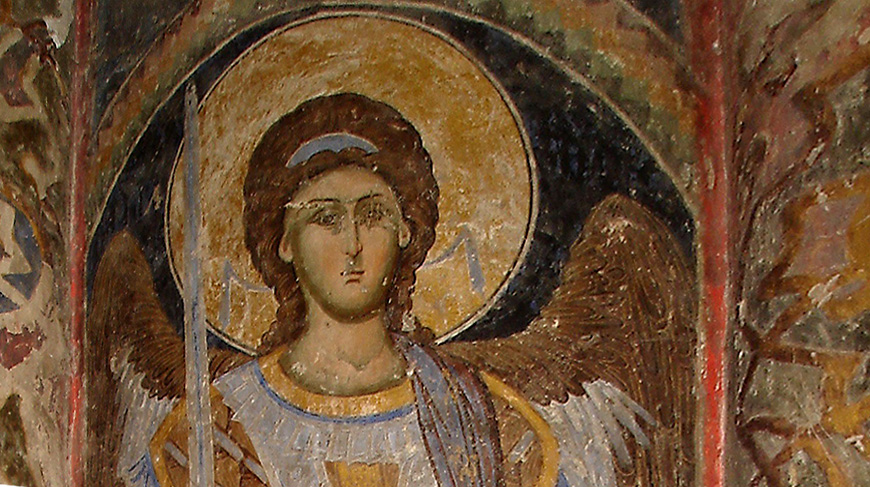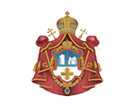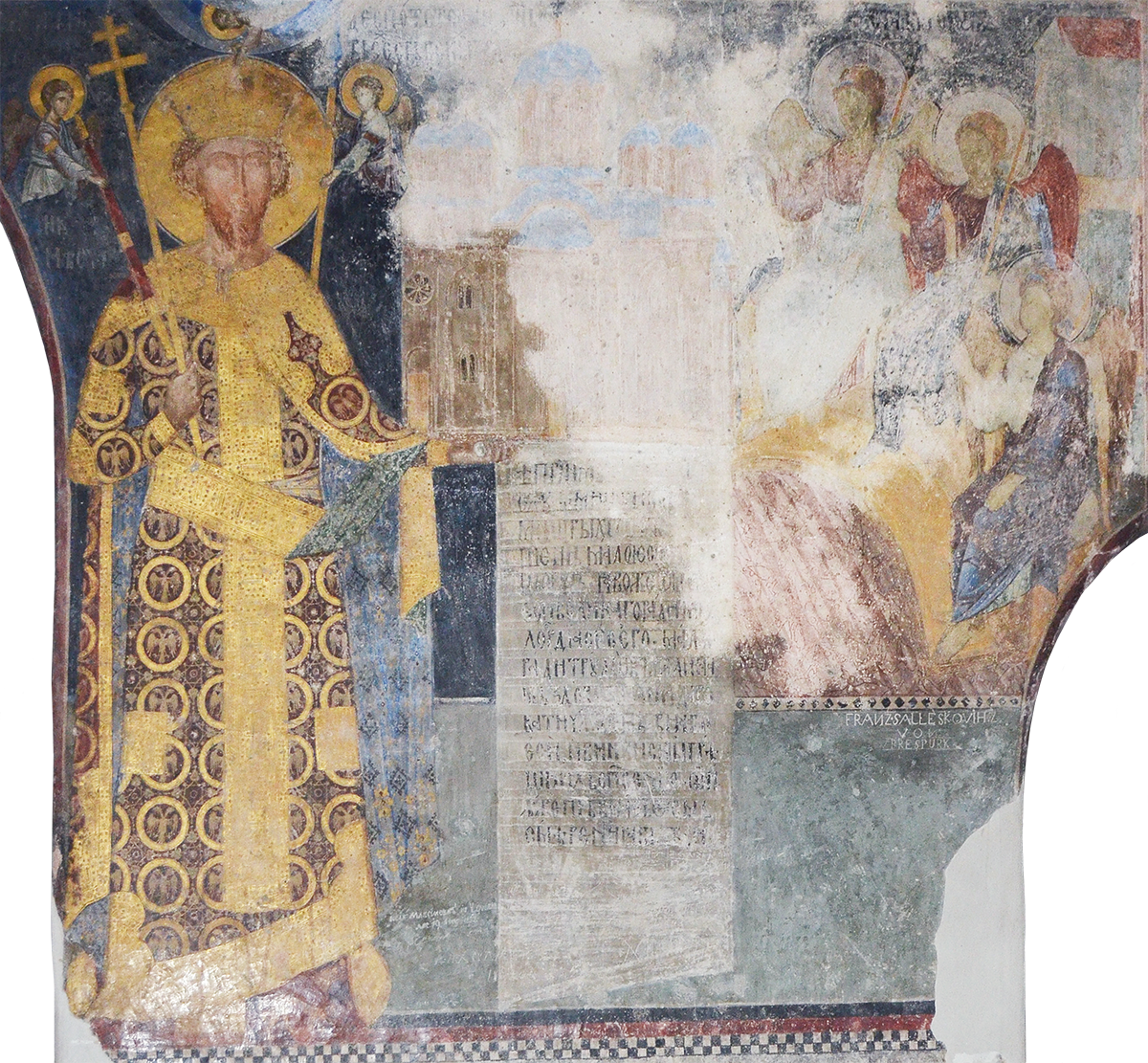The Church of the Holy Trinity
Frescoes
THE BEAUTY OF MANASIJA PAINTINGS PLACE THEM AMONG THE MOST IMPORTANT ACHIEVEMENTS OF THE MEDEIVAL SERBIAN PAINTING
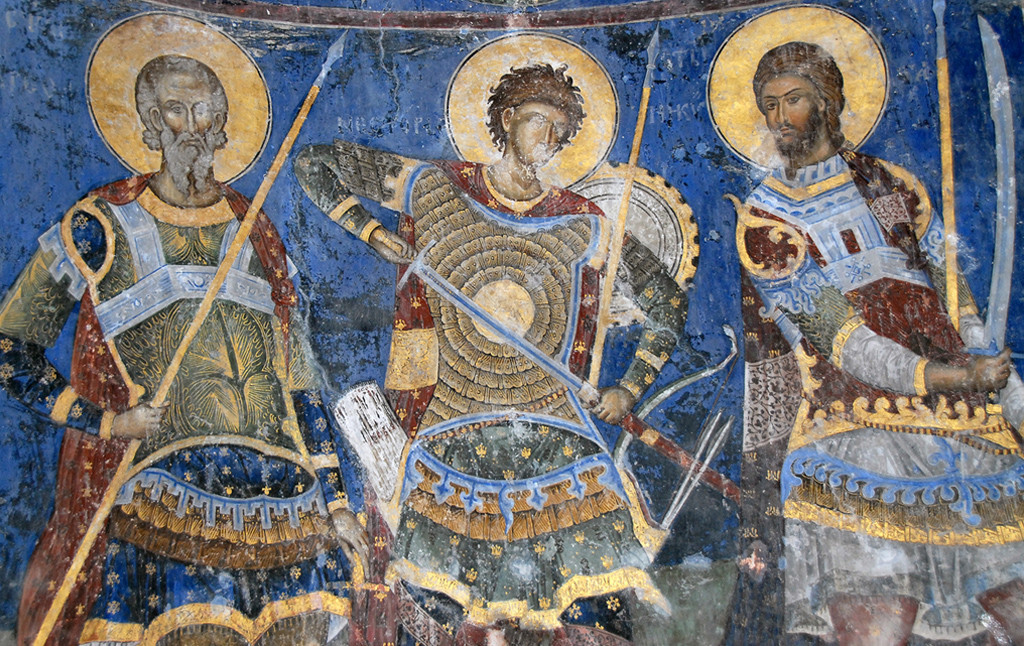
-
The Manasija paintings are not fully preserved. The inscriptions about the time of their creation are also missing. It seems probable that it was already completed in 1418. That year, according to the writings of an unknown chronicler, on the Holy Trinity Day, Despot Stefan called the people to convene at his foundation on the occasion of its consecration. Commenced a year or two earlier, the Resava paintings had certainly been made immediately before the day of this celebration.
In the entire remaining Byzantine monumental painting, the highest achievement in the 13th century was that of Sopoćani paintings (in the only church dedicated to the same holy day), and in the 15th century, it was the paintings of Manasija.
The time in which the Morava school magnificence was created offers invaluable elements for the analysis of the Resava painting phenomenon from multiple aspects. The Byzantine world and the West at the time of early Renaissance were increasingly getting closer to each other. The bright light of progress in the West penetrated the Byzantium at that time. The famous Venetian and Genoan colonies in the very vicinity of Constantinople not only traded with the most famous city of the East, but also transferred new ideas. The spirit of realism and the humanism of the early Renaissance gradually broke through the strongholds of strict stylization of the Byzantine fine arts.
The economic relations of Serbia were directed mostly towards the Adriatic coast and the Apennine Peninsula Therefore, the penetration of western artistic influences in Serbia was faster and stronger. The artistic culture of the Morava School was influenced by such political, economic and cultural ties. The Manasija paintings are its brilliant climax and its most impressive characteristic.
Many historical documents testify to the high regard in which the beauty of Resava paintings was held. From the Constantine the Philosopher, through the 15th century Karlovački Rodoslov, and more intensely towards the end of the 18th century, every decade provided more and more information about the Manasija paintings. All this information suggests that the church “paintings were so beautiful that all Serbian lands talked about them as if they were a miracle”, but that the Turks, “picked out the eyes of the saints, scratched the walls and committed many shameless acts”.
-
Of the former paintings that adorned the entire interior walls of the church with the narthex (about 2,000 m2), just over on third has been preserved to this day. The original paintings in the narthex disappeared. During the conservation works, small, completely faded fragments were discovered, the contents of which can hardly be discerned. The surviving frescoes in the main part of the church, the naos, offer a possibility to understand their original layout and indicate what they were like in their entirety. Certain preserved monumental compositions and individual figures of saints reveal the order of the painting topics by zone.
The frescoes of Resava represent the climax of the renaissance of artistic development of the line of the Paleologues in Serbia. It has been a long time that Vojislav Djurić recognised their predecessor in style on the frescoes in the narthex of the church of the prophet Elijah in Thessalonica (around 1360-1370), so as on the frescoes alike, in terms of style, in the paraklis of the church of the Saint Soothsay in Vatoped (around 1370), focusing the origin from Thessalonica of the paints of Resava, trained according of the best artistic traditions of the metropolis of the kingdom, Constantinople. However, Resava has no modern paintings, as in the two churched mentioned. Even the data from the biographer of the Despot Stefan Constantine, The Philosopher who is only mentioning, describing the efforts of the founder in the construction and the decoration of the church, that the despot reunited “the most talented and most famous workers” calling them from everywhere, even from remote islands. The Despot Stefan, aristocrat brilliantly educated, cosmopolitan and with a good knowledge of arts, really brought the most experienced painters, in the whole Byzantine circle. They painted in Resava frescoes of an exceptional beauty, aristocratic elegance, a rich palette, with a fine spiritual message – elitist by their belonging because they have been painted according to the rules of the Despot Stefan himself, a representative of a spiritual and social elite that Serbia never had after. In the Serbian Morava region, in the principality of the Despot Stefan Lazarević has been created a spiritual and artistic atmosphere where the classicist late Byzantine chef-d’oeuvre of the time of the Paleologues in Resava could be created.
The Order of Themes and Explanation of Paintings by Zone
The disposition of frescoes is adapted to the architectural conception and to the sacral function of the inner spaces of the temple, with the application of the hierarchic principle “of the vertical and horizontal saint” in the repartition of the themes in the orthodox churches of the Byzantine artistic circle.
The shining of the painting in the temple filled the faithful with spiritual beauty of the ideal world, in which reigns the cosmic order, therefore the very entrance in the temple was for them equal to the entry in heaven.
Calotte of the Main Dome
-
The program of the fresco painting in Resava began in the calotte of the main dome where was painted the bust of the Christ Pantocrator. The Son of God, lord of the earth and heaven, communicates from the calotte with the terrestrial world. The celestial liturgy celebrated by the angels in heaven as the priest on the earth, was painted in the spherical ring surrounding the Pantocrator. Now are only seen fragments of the angelic feet of this procession.
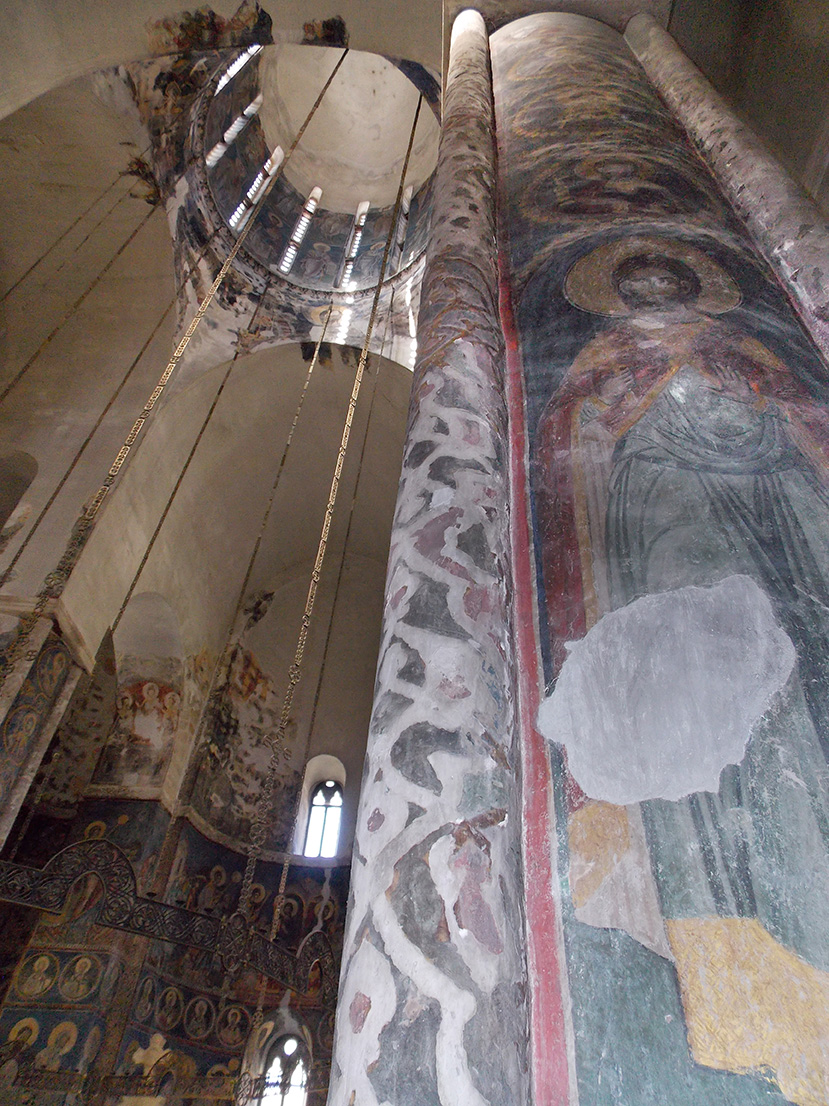
In the history on the human gender God appeared for the first time before a little number of persons of the Old Testament, to the prophets, giving them the visions on the fore coming events and the apparition of the Saviour of the New Testament. Therefore, the Prophets deserve a place in the tambour of the dome – the nearest to God. In the dodecagonal tambour of the main dome of the monastery of Resava, between twelve high and narrow windows,
-
24 monumental figures of the prophets, of the kings of the Old Testament and the first prelates, the majority of whom hold rolls with the written texts of their visions-prophecies, are painted in two rows. Most of the prophets are represented in hiton and himation, whereas five of them are in the chasubles of the kings of the Old Testament and of the first prelates.
In the inferior zone, below Saint Ely, in the east part of the tambour, is painted the prophet Sophony, then Abdias, Aggie (with a high roll), Nahum, Gideon, Hoses, and Amos. The first priests of the Old Testament hold in their hands their attributes of the metamorphosis of the role of Christ as the first prelate of his church on earth. The prophet Samuel hold the horn with the oil of unction and the roll, and the prophet Zachary, father of John the precursor the first Jewish priest holds a censer and a roll. Aaron holds a leafed stick and a roll and Moses is the only one among the prophets without a roll and with both hands is holding an amphora containing the richness decorated by the bust of the Holy Virgin. The prophet Michee is represented below John The Precursor and closes the circle in the inferior belt of the prophets, blessing with his right hand and in the left hand, he’s holding a roll.
The profiled circular cornice in the shape of a ring at the bottom of the tambour is decorated with stucco and covered by paintings representing a wine plant andflowers. On the mural surfaces below the cornice are painted, in the east and in the west, the Mandilion and Keramion, non personalised images of the Christ; in the north and the south is represented the hand of god; and in the pendants, the Evangelists.
Pendentives
-
Although the prophets of the Old Testament could only have in their visions, the arrival of the Christ, the Evangelists were the genuine witnesses, the incarnation, of his real sojourn on earth, his works realised among the people, and of his epiphany. Matthew, Mark, Luke and John, the authors of the four Holy Gospels – manuscripts considered in the Christian doctrine as the basis of the science of Christ and of fundamental “substrata” of the Christian faith – are usually painted in the spherical triangles below the tambour. John the Evangelist is represented in the southeast pendent, seated in the cavern in the island of Patmos, turning himself towards the east, he’s receiving the inspiration for the dictated words to his disciple Prohoros from a ray of light from a segment of the sky. In the south west pendant, Mark the evangelist, seated in his office, in an edifice with a very luxurious architecture, is reading an already written book and behind him as an antique muse, is represented the personification of the divine supreme wisdom, and is showing the text in the book. The evangelist Luke is painted seated in the scriptorium of a two-floors building with elegant porticos and a garden with cypresses. The personification of supreme wisdom is represented next to his left shoulder and is showing the already written gospel on the back of the chair, whereas Luke is sharpening his feather and is preparing himself to copy the text in the empty book he is holding on his knees.
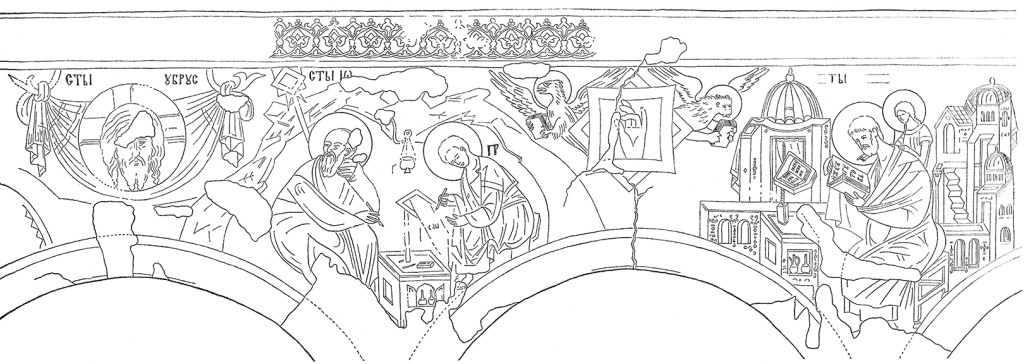
-
The Evangelist Matthew is creating his text according the conception of God; while seated in a several flour sumptuous building with terraces, a circular stairway and a ciborium, the supreme wisdom is represented behind him.
The Christian church, during its long history has specially nourished the cult of icons. The oldest icons, so-called impersonal icons, representing the “impersonal jaws” of the Christ on the Saint winding-sheet and on the Holy Keramida are specially celebrated. These icons were considered as miraculous representations of the face of the Christ. The two impersonal jaws, as an authentic evidence of the incarnation of the Christ, are represented in the Byzantine and Serbian churches, in the space below the dome, between the pendentives. The winding sheet is painted at the monastery of Resava on the east side, between the evangelists John and Matthew. The endings of the white winding sheet, with the face of the Christ in the aureole in the shape of a cross, are tied to the decorative supporter. On the west side, between the evangelists Mark and Luke, is the Holy Keramida with the face of the Christ in the aureole in the form of a cross. On the south and north mural surface God’s hand is painted, between the pendentives is painted God’s hand in a gesture of benediction, framed by a squared segment of the “heaven”.
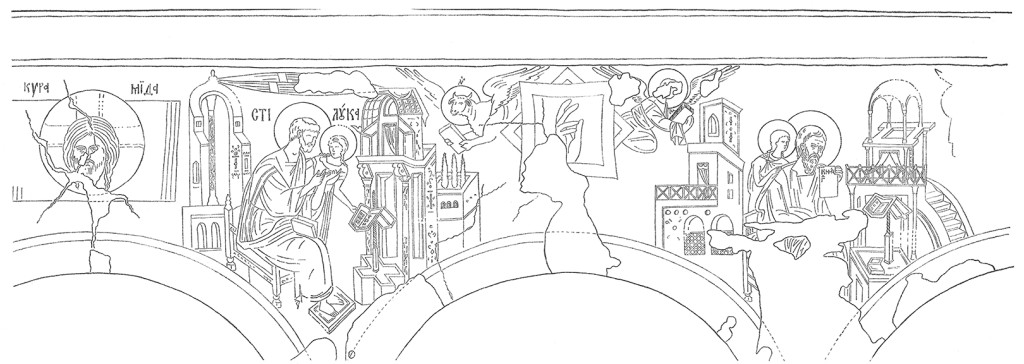
The Four Little Domes
-
The main dome is decorated by a complex choice of figures whereas in the four little domes, the decoration is much more reduced. Now it is only preserved in the tambours and, in fragments in their zones below the dome. The calottes, apart from those in the southwest, don’t have frescoes anymore. The all four tambours are covered with paintings of “ incorporeal forces”- ranks of angels who celebrate God in the heights. The incorporeal forces are grouped in the representations of cherubs and seraphs, of the representations of the throne (tied winged wheels with many eyes),
-
the archangels and the angels, accompanied with the three-time sainted verses – “ World, world, world Lord Hosanna, the heaven and the earth are filled with the glory of his”, actually the beginning of the text of the hymn celebrating the Holy Virgin: “More honourable than the cherubs and more glorious than the seraphs…”. The representations of the ancestors of the prophets and the Just of the Old Testament are only discerned in some places on the mural surfaces below the dome.
Zone of the Altar
-
The frescoes in the zone of the altar represent the most ordered ensemble of the frescoes of the monastery of Resava. On the frontal part of the arch, around the semi-calotte of the apse was written the verse from the psalm 26-8: ” Lord, I started loving the beauty of your home”.
The Holy Virgin on the throne with the Christ on her knees surrounded by inclined angels was represented in the semi-calotte. Nowadays are only seen the parts of the figures of angels. Below this representation are painted the scenes of the cycle of the apparitions of the Christ after the resurrection of his. In the all four evangels are described the events during the forty days of the sojourn of the Christ among the men on the earth, which is read during the masses and the matins between Easter and Whitsunday, and visualised by the scenes of the post-mortem apparitions, often painted, since the 13th century, in the altars of Christian churches because of their importance and their symbolic. The important liturgists explain the exceptional influence of the post-mortem apparitions of the Christ on the liturgy because sojourning with the apostles; the Christ gave them “ the divine mastery of salvation with which he salves the world”. This conception of the program is used in the monastery of Resava.
The first preserved painting, the apostle Peter next to the opened grave of the Christ, is situated on the north side of the altar. In the grave are only seen the shrouds with which were enveloped the body and the head of the Christ. In the scene “The Christ showing to the apostles his hands and feet”, the Christ is standing in the centre, among the apostles who express by their gestures and movements a visible exaltation, and invites them not to be afraid but to come nearer, to see and to touch his wounds (from the cross) on the hands and feet and to convince themselves of his material apparition after the resurrection. The Christ continues speaking with the mistrustful disciples asking them to eat something, which is represented, according to the text of the evangel in the scene “ the Christ is eating the honey and the fish”. The Christ is represented behind the hexagonal table on which are the containers with a piece of fish and honey, approach
-
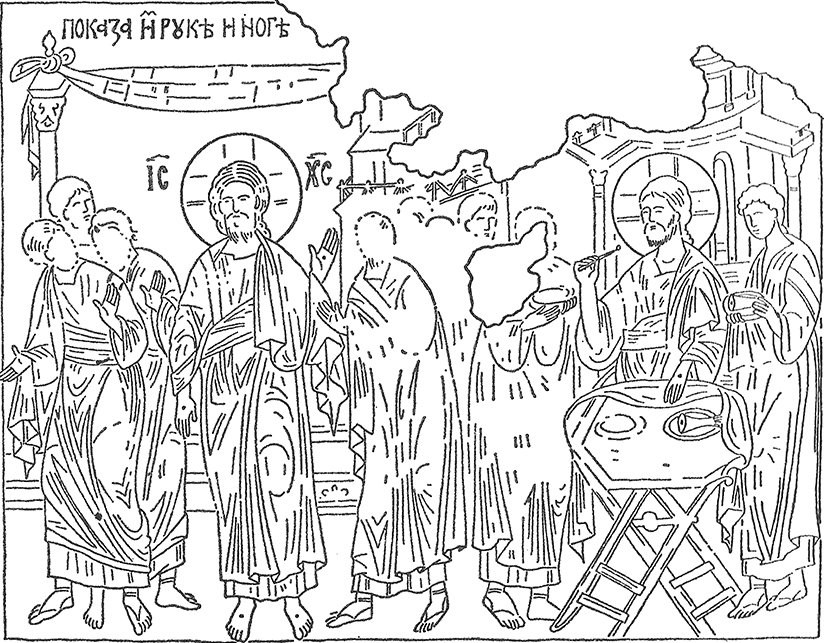
the fish to their mouth, while the apostles go towards him bringing him the containers with the offertories.
On the south of the apsidal window, is seen a part of the scene of the apparition of Christ on the Galilean lake when the Christ taught the apostles how to throw the net in the sea and took out “a lot of them”, whereas the apostle Peter, surprised by the apparition of the Christ throw himself to the sea.
This event continues on the south pilaster with the episode “ the Christ with the fire, the loaf and the wine” Peter, leave my sheep graze” is the last scene of the cycle of the apparitions of the Christ after is resurrection. In the right hand side of the first plan, is painted the Christ with the stretched arms, around him are the apostles and above them the preserved parts of the long text where the Christ is speaking to Saint Peter.
The Scenes “Blessing of the Apostles” and “Service of the Holy liturgy”
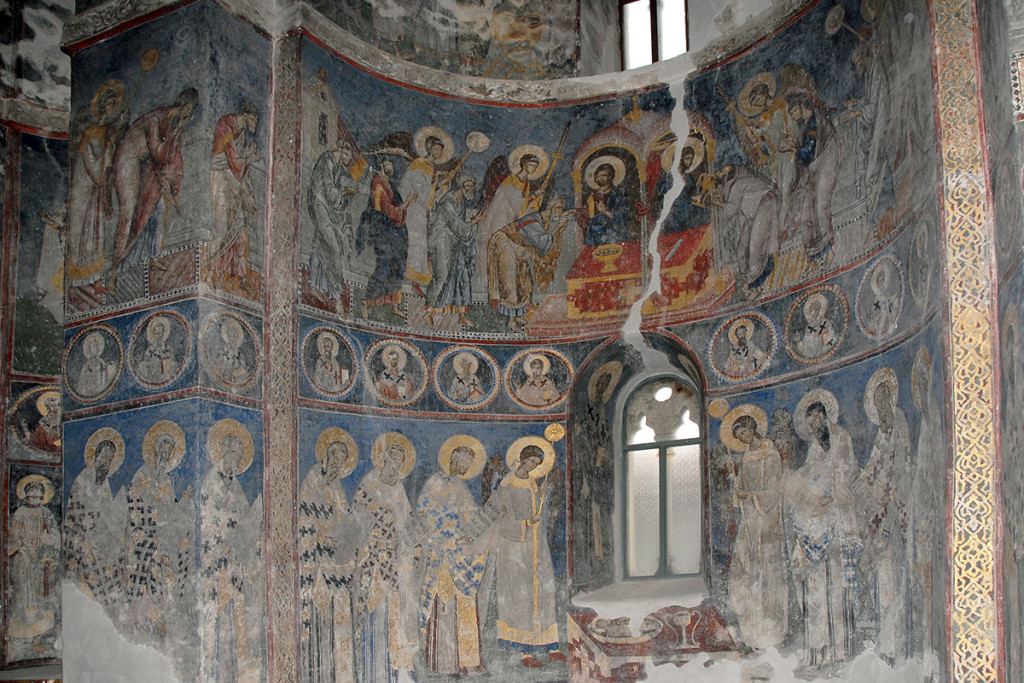
-
The scene of the Benediction of the apostles is developed in the central horizontal zone of the apse of the altar, below the cornice, decorated with a floral ornament, on the whole width of the apse of the altar and on the frontal part of the pilasters. According to the established iconography, the Christ is represented twice in the centre of the apse, standing next to the honour table, below the canopy. He is blessing with the loaf a group of apostles; arriving from the north, lead by Peter. The apostle Peter is bowing and kissing the hand of the Christ receiving a piece of the loaf with his hands in a symbolical gesture of communion. After him, five apostles come with solemnly and peacefully gestures, preparing themselves to receive the blessed loaf. On the south half of the scene the Christ is represented on his profile, is blessing with the wine, the apostle Paul who, drinking the consecrated wine, is looking at the Christ, uniting his hands praying. The other five also arrive with their praying opened arms. And the Christ and the apostles are dressed in Hition and Himation. Angels – deacons carrying the candlesticks and candelabrums, follow the processions of the apostles. All these figures move in an imaginary world that is, characteristic for Byzantine aesthetic, underlined by architectural elements as a symbol of the real architecture. Along the upper edge of the scene it is possible to read the parts of the words the Christ said, as the evangels testify, to the apostles during the Last Supper: “ And when they ate, The Christ took the loaf, blessed it, broke it and gave them saying: ‘Take it, eat it; this is my body’. Then he took the cup, praised it, and gave them saying: ‘Drink it all of you; because this is my blood of a new pledge which is going to flow for many men, in order their sins to be forgiven”. The picture of the blessing of the apostles by the Christ presented to the people the dogma of the salutary sacrifice of the Christ – the liturgical role of the Christ, giving himself to sacrifice as blessed wine and loaf.
In the spacious sanctuary of Resava an important number of faces of bishops are painted in the apse of the altar, below the scene of the benediction of apostles, on the walls of the proscomidium and of the diakonicon, and on the east side of the pair of pillars of the altar, and are symbolically united in the eternal service of the Holy liturgy, in all times, in all countries of the Christian Orient.
-
The fourteen most respectful bishops contribute, in the first zone of the altar, to the scene called “Service of the Holy liturgy”, which symbolically represent the dogma of the sacrifice of The Christ and its permanent renewal in the real liturgy.
In the liturgical cortege, the Holy fathers, faces turned ¼, are approaching the centre of the apse, where is represented the honour table with the Christ-sacrifice, as a lying child in the crib, blessing. Two angels, bend above the honour table with the Amnos and the chalice, waving the candlesticks, whereas approach from the north: Saint John Chrysostome, Saint Gregorios the Theologian, Saint Jacob brother of God, Saint Nicholas of Myra, Saint John the Almsgiver and Saint Sava the Serbian, and from the south: Saint Basil the Great, Saint Athanasios of Alexandria, Saint Cyril of Alexandria, Saint Gregorios the small one, Saint Sylvester the roman pope and Saint Spiridon. The honour table with the Amnos is in the ideological axis of the altar, in the vertical of which is the honour table, behind which the Christ serves in the scene “ Blessing of the Apostles”. The painting explicitly shows the permanent presence of the Christ, whose sacrifice the people receive through the prayers and the Eucharist – benediction during the liturgy, when the people unite with him, for future salvation.
In Resava, in an ideal and permanent liturgical ritual also participate other bishops, of which are shown either the busts or the figures, dressed with Episcopal liturgical costumes, holding in their left hand the gospel and blessing with their right hand. In the horizontal rank of the medallions, in the zone between the compositions “ Benediction of the Apostles” and “ the Office of the Bishops» are painted the busts of the fourteen Bishops. On the north side of the altar it is only possible to read the names of Saint Ananios and Saint Sylvan of Thessalonica and on the south side of the apse of the altar are well preserved portraits and inscriptions: Saint Stakhios of Byzantium, Saint Simeon of Jerusalem, Saint Lukas Laudikios, Saint Apelis of Smyrna, Saint Christovul, Saint Rhodion of Pataros and Saint Flegont of Sparta. In the lower window of the apse, are painted the standing figures of Saint Gregorios Akragantski and Saint Gregorios the Armenian, whereas on the north side of the upper window of the altar apse, is only seen a part of the representation of an unknown ecclesiastic.
The Proscomidium and the Diakonicon – the Paintings of the Saint Bishops
-
In the proscomidium and in the diakonicon, dominate the paintings of the saint bishops. On the highest part of the apse of the proscomidium is located the damaged figure of a prelate, and below him, the well preserved figure of Saint Polycarp, bishop of Smyrna. Above the east window of the proscomidium there are two medallions with the busts of the saint bishops Erasthon of Jerusalem and Sosten Kolofonijski, whereas on the lateral sides of this window, are represented the standing figures of two saint bishops – Saint Antim, on the south side, and an unknown bishop on the north side of the window. On the north wall of the proscomidium, below the inferior window, are painted in medallions the busts of three unknown saint bishops, and above the window one more medallion with the bust of the bishop of Jerusalem and on the inner sides of this same windows are represented two standing figures – Saint Epiphany of Cyprus and an unknown bishop. In the proscomidium, next to the saint bishops are painted three saint deacons. As in the liturgy, the service of deacons is considered as equal to the service of angels in the celestial liturgy, the representations of the saint deacons have been introduced in the painting program of the pastophoria, next to the principal altar of the church. Saint Evplo and Saint Roman are represented of both sides of the windows of the apse of the prothesis, holding in their right hand a hanging incensory and in the left one, covered by a hooded cape, carrying the ciborium with Host.
-
According to the remained fragments of two angels below them, the position of their right hand with the hanging incensory, it is possible to figure out the original scene of the Christ-Amnos. Saint Stefan the First Martyr as a deacon is represented immediately next to Saint Evplo, on the north wall of the proscomidium. All three Saint Deacons are represented as young men with a tonsure on the top of the head (shaved hair), dressed in a long robe pleated above which falls the orar (in the form of a ribbon) on which are written the Greek words of the “Trisagion”.
In the diakonicon are the individual representations of the ecclesiastics and two narrative compositions disposed in the identical order to the one in the proscomidium. The Saint Bishop in the highest zone of the apse is only partially visible, in the lower part. Below it, in the second zone, is represented the Saint Bishop Sofronie of Jerusalem, who is holding a written roll in his left hand and blessing with his right hand. Above the windows in the apse the busts of two unknown bishops are painted in medallions and on the inner sides of this window are painted the busts of Saint Patapios and Saint Vlasia, Bishop of Sevast. In the apse on the mural frontal surfaces around the windows are painted the saint bishops – Timothy of Ephesus and Jason Iconisios. On the south wall three more representations of the saint bishops. On the east of the lower window, is painted Saint Philoteos, and above him, in a medallion the bust of the bishop from Appolonios, and on the east side of the opening of the window is the picture of the bishop of Mediolanskos.
The Pillars
-
The saint prelates of the church, united in the altar space of the monastery of Resava, are rejoined by Saint Peter of Alexandria, painted on the south side of the northeast pillar in the representation of his vision. On the east side of the east pair of pillars, turned towards the altar, are painted the six standing hieratic bishops, disposed in two rows of three on each pillar. The names of Saint Partenios and Saint Teophanos, on the pillar northeast, are the only ones visible. Among the most famous Christian orthodox bishops, creators and founders of the most ancient patriarchies and local dioceses, is painted Saint Sava the Serbian, leader of the Serbian Church, which is contributing to the synod of the Christian peoples.
-
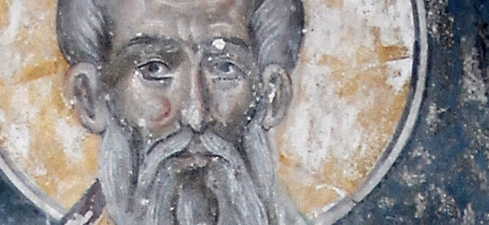
The Zone of Vaults below the Dome
-
The most important events of the life of the Christ are celebrated as the greatest feasts of the Christian liturgical calendar and are represented by the Cycle of the scenes of Great Celebrations that are the essential and compulsory part of the theme represented in each and every orthodox temple. According to the long iconographic tradition, the scenes of the great celebrations in Resava were represented in the zone of vaults below the dome, which can be noticed by the insignificant remains of a few scenes of celebrations. The Annunciation, the first scene of the cycle of the Great Celebrations, is painted above the east pair of pillars below the dome. The archangel Gabriel, of whom some fragments of the feet are visible now, is represented above the northeast pillars, in the moment he landed in the quarters of the Holy Virgin, bringing her the rejoicing news, she’ll give birth to the saviour of the world. On a surface alike, above the south east pillar, is seen only a part of the scene where was represented the Holy Virgin, the elected of the upper force, seated in her room, listening with surprise the words of the archangel. The scene of the “ Birth of the Christ” has been painted on the east part of the south vault below the dome, of which today testify the remains of the inscription.
-
On the south part of the west vault below the dome is recognized the scene “ The Baptism of the Christ” and the scene of the descent of the Holy Spirit on the apostles covered the north half of the west vault. On the remains of the fresco, are only seen three out of twelve apostles, seated on a half circular bench while the Holy Spirit in the form of burning tongues landed on their heads preparing them to preach in different languages, trough the whole world, the word of the Christ. The scene “Ascension of the Christ” covered the whole east vault. Today, on the only fragment of the ancient great composition, is only seen a part of the face of the Christ, surrounded by a mandorla of the divine lights, in which the angels carry him away in heaven. The Assumption of the Holy Virgin is the last composition of the cycle of the great celebrations. It covers an important surface in the upper part of the west wall of the naos. The end of the life of the Holy Virgin isn’t described in the gospels but in apocryphal texts, on which is based the formation, relatively long of the iconography of the scene.
The scene “The Assumption of the Holy Virgin”

-
The scene of the Assumption in Resava is a simple and clear composition, at the centre of which is represented in the first plan, the Holy Virgin lied “asleep” on her catafalque with the crossed hand on her breast. Four lightened candlesticks in high candle are before and behind the catafalque. Behind the middle of the catafalque is represented the Christ in his lightened double mandorla and with his covered hand, he’s holding the personification of the soul of his mother represented, according the established iconographical formula, as a child enveloped in his nappies. In the segment of the third mandorla, around the Christ fly the angels who must carry away the soul of the Holy Virgin to heaven. Two angels are carrying lightened candles, two of them with crossed hands and a six-wings cherub and the labarum fly on the top of the mandorla. The apostles and four bishops who mourn the Mother of God are represented sadly around her catafalque. The apostle Peter and a bishop are executing the ritual of the incensory.
-
The apostle Peter is holding a hanging incensory and the bishop a manual one next to the catafalque of the Holy Virgin. The women from Jerusalem, standing at the back of the scene, are also weeping the Holy Virgin. In front of her catafalque is represented an episode with Jefonije, a Jew who tempted to throw the corpse from the catafalque that an angel hindered – cut his arms. In the upper segment of the composition divided in two parts around the window opened towards the narthex, only two apostles are seen arriving on clouds to Jerusalem, from remote regions of the word, where they spread the faith of the Christ, to honour the defunct Holy Virgin. The painting of the death of the Holy Virgin in the Church of the Holy Trinity of the monastery of Resava, although not entirely preserved, show the omission of extra episodes and poetical comparisons, nourished in Serbian art of the 14th century.
-
The history before the Old Testament is full of transformations and allusions about the events that took place in the evangelical period, after the birth of the Christ. From the cycle of the themes of the Old Testament only three scenes are partially visible, disposed in the highest part of the arches between the east wall and the east pair of pillars. The scene “ Three young Jewish in the burning oven”, on the east side of the arch between the north east and the east wall, is representing three young employees of the Emperor Nabucondonosor, miraculously saved, after being thrown the flames because they refused to worship the statue of the golden idol. On the west part of the highest part of the same arch is visible a fragment of Noah The Just with the ark, which was given to him by God in order to save himself, with a couple of all the living animals, from the great deluge, and to multiply his descendants, because God recognised him as the only just man in the whole fallen human gender. The third scene of the Old Testament “The Sacrifice of Abraham” represented in the space of the altar on the east side of the arch between the south west pillar and the east wall. In the scheme of vertical composition is represented Abraham taking away his son Isaac and preparing him to the sacrifice to God, believing to the divine miracle of the resurrection. By stopping Abraham’s lift hand with the knife over his son, God saved Isaac and rewarded Abraham, dispersing his descendent in future centuries, during which will be born the Holy Virgin and from her the Christ. The dogmatists underline the possible comparison between the sacrifice and the faith in resurrection – of Abraham and the Christ.
-
The cycle of the paintings of the childhood and the youth of the Holy Virgin with several damaged scenes, disposed in the highest zone of the south wall, is accompanied with the proto-gospel apocryphal text of Jacob. The first scene of the cycle, “The Refusal of offerings of Joachim and Ann”, which is located in the highest zone of the south wall of the diakonicon, represents the first priest of the temple of Jerusalem, standing on a base in a form of a stairway in front of the closed altar extending his arms towards Joachim and Ann. They leave the temple because, while they didn’t have a child, it was prohibited to make a sacrifice in the temple. Ann is taking away in her covered arms the pigeons to be sacrificed and Joseph is following her, carrying away his lamb, also to be sacrificed. The cycle is following itself in the south choir with the scene “meeting of Mary and Elisabeth”. The two other scenes of the cycle of the Holy Virgin in the south choir have not been identified and another painting in a poor condition, below the southwest dome, has been recognised as the scene “Cherish of the Holy Virgin”.
Several compositions partially visible on the surfaces above the southwest pillar are linked to the Birth of the Christ. It is represent the evangelic history of three oriental three wise men who learnt about the birth of the Messiah came to Bethlehem to kneel before him: “The trip of the three wise men to Bethlehem”, “The kneeling of the three wise men» and two scenes with Herod, at the time emperor of Judea.
The cycle of “The Passion of the Christ”
-
The cycle of “The Passion of the Christ”, which evokes the events from the “Last Supper”, to the resurrection is represented in a few fragmented paintings in the north part of the naos. The first among the rest of the scenes is “Judas is receiving the silver coins”, painted on the east side of the wall above the north west pillar, is representing the apostle Judas below the porch of a building with a dome receiving a purse containing the silver coins aimed to betray the Christ. On the north part of the same wall is represented the scene “ Leading of the Christ to Ann and Kayaf”, which took place after the treason of Judas. The first priests are seated on a bench on the right side, and Kayaf accusing the Christ of blasphemy, is tearing furiously with his both hands his cloths on the breast. On the north side of the wall, above the northeast pillar, is painted the well-preserved scene “Joseph from Arimatia demanding the corpse of the Christ to Ponce Pilate”.
-
Joseph, bent, is approaching from the right with his hands stretched, suppliant Pilate to authorise the funeral of the Christ crucified. After having obtained the permission from Pilate, he buried the Christ in a new grave of stone, but Pilate ordered its reinforcement. This event, “The Seals from the grave of the Christ”, as the last preserved scene of the cycle of the passion of the Christ, is represented on the north wall of the proscomidium. In a rocky landscape, three ecclesiastical prelates and Pharisees nailing the marble sarcophagi laid diagonally, whereas four soldiers are seated on the ground in front of the sarcophagi. Introduced in the space of the altar, the cycle – “Passion of the Christ”, logically continues in the cycle of the “Apparitions of the Christ after his resurrection”, is represented below the painting of the Holy Virgin in the apse of Resava.
The walls, upper zone – Miracles of Jesus Christ
-
The events of the terrestrial life of the Christ that took place before its passion are described in details in the gospels and are called miracles, parables and lessons of the Christ or the public activity of the Christ. At the monastery of Resava, these events are closer to the public being painted in above the standing figures and the busts of the saints in medallions. The cycle is discontinued because of the damaging of paintings and, begins and ends in the space of the altar. The first scene, “ The Wedding of Cana” is represented on the south wall of the diakonicon and the other compositions in the south choir: the scene “The 12 year old Christ learning in the Temple”, the parable “Pharisee and the Publican” and the parable “The Prodigal Son”. On the west wall among the scenes of the mysteries, is clearly seen the composition “The multiplication of loaves” and on the north wall, among the three scenes of mysteries the central scene is the only clearly visible one – “The healing of the dropsy”. In the north choir are represented: the parable “ the wedding feast”, the parable “The Rich Man and the Beggar Lazarus”, and the parable “The Good Samaritan”. The last miracle of the cycle: “healing of the daughter of Hannaneika”, is painted in the space of the altar, on the north wall of the proscomidium.
In Cana, in Galilee took place the first “miracle of the revelation” on the Christ’s way of revelation (to the people) of the glory of the Son of God and the announce of the reality of the Divine kingdom. The young married, dressed with sumptuous nuptial costumes, chatting around the nuptial table and the Holy Virgin is informing the Christ there is no wine left. The episode when the Christ turned “ six barrels of water” into wine has not been preserved. The first apparition of the Christ in his childhood is described in the scene “The 12 year old Christ learning in the Temple”. On the east side of the south choir is painted the Christ as a 12 year old boy, seated on a semi-circular bench at the centre of a temple of Jerusalem, blessing with his right hand and holding in his left hand a roll symbol of the knowledge. On the bench, next to the Christ, are seated the teachers enchanted by his spirit and his answers.
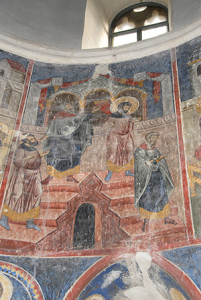 The parable “Pharisee and the Publican” is a lesson on the mercy and the forgiving of the Christ. In the temple, represented in the second plan of the scene under the form of a stretched porch with a three-parts altar, there is a double-sided stairway. In the left side of the steps, pray the Pharisee and the Publican; the former with the risen hand and the latter is repenting, with his hands raised looking at the sky. Only the prayer of the publican, sincere and repenting has been fulfilled with an aureole he is going out of the temple on the other side of steps, whereas the Pharisee is going away discouraged with his arms cross. The parable “The Pharisee and the publican” has been exposed to the faithful as an allusion of the fact the Just will be separated from the Sinners before the Last Judgement and the humiliated will be elevated because, the genuine humbleness and the total spiritual self-communion appealing to God, are the precondition to reach the highest Christian values, of the kingdom of God. The parable “The prodigal son”, as a representation of the dogma of the sincere forgiveness and repent, is rarely painted in monumental art of the Byzantine circle. The scene in Resava represents several episodes of this event: the seated Christ in front of the rectangular table and in the role the father, holding a scale, he weights the coins equally for his two sons who are stretching their arms towards him, standing on the opposite of the table; followed by the episodes of the departure of the youngest son in the world where he abandoned himself to the sins and vices;returning repenting, The Father-Christ is hugging him accepting the return of his lost and fallen son forgiving him his sins because of his sincere repenting; the episode in which the Christ is introducing the furious elder son, unsatisfied with the leaky behaviour of his father towards the fallen character of his brother, is poorly preserved.
The parable “Pharisee and the Publican” is a lesson on the mercy and the forgiving of the Christ. In the temple, represented in the second plan of the scene under the form of a stretched porch with a three-parts altar, there is a double-sided stairway. In the left side of the steps, pray the Pharisee and the Publican; the former with the risen hand and the latter is repenting, with his hands raised looking at the sky. Only the prayer of the publican, sincere and repenting has been fulfilled with an aureole he is going out of the temple on the other side of steps, whereas the Pharisee is going away discouraged with his arms cross. The parable “The Pharisee and the publican” has been exposed to the faithful as an allusion of the fact the Just will be separated from the Sinners before the Last Judgement and the humiliated will be elevated because, the genuine humbleness and the total spiritual self-communion appealing to God, are the precondition to reach the highest Christian values, of the kingdom of God. The parable “The prodigal son”, as a representation of the dogma of the sincere forgiveness and repent, is rarely painted in monumental art of the Byzantine circle. The scene in Resava represents several episodes of this event: the seated Christ in front of the rectangular table and in the role the father, holding a scale, he weights the coins equally for his two sons who are stretching their arms towards him, standing on the opposite of the table; followed by the episodes of the departure of the youngest son in the world where he abandoned himself to the sins and vices;returning repenting, The Father-Christ is hugging him accepting the return of his lost and fallen son forgiving him his sins because of his sincere repenting; the episode in which the Christ is introducing the furious elder son, unsatisfied with the leaky behaviour of his father towards the fallen character of his brother, is poorly preserved. -
On the west wall of the naos, below the assumption of the Holy Virgin, among several scenes of the miracles of the Christ, is only clearly seen the monumental composition “Multiplication of the loafs”, described by the evangelists as a miracle where the Christ fed five thousand starving persons, miraculously multiplying only five loafs and two fish. In the middle of the painting, unique by its composition and disposition of various episodes represented on the sides of smooth hills, the Christ is standing holding in his stretched hands five loafs one on the other and two fish. The Christ is lifting his look towards the sky, and them begins the mystic multiplication of the loaf and the fish, the apostles are distributing to the people with full baskets, disposed on the hills.
On the north wall of the west bay, among the three scenes of the miracles of the Christ, is only recognised the central composition “ The healing of a man with dropsy”, which concretises the healing miraculous power of the Christ. Below the cornice of the north choir, are disposed three scenes of parables of the Christ. The parable “ the Wedding feast” representing the guest gathered at a festive table with plenty of food and a lot of drinks in luxurious crockery. The distinguish guests are chatting. The Christ dressed as a king, is seated at the frontal part of the table, and an angel behind the table, and is pulling an inadequately dressed guest by the hair to the fire, in an opened niche on the right hand side. This scene is an allusion to the table of the Christ with the Eucharist to which the elected are invited the Elected. The parable of the “Rich man and the beggar Lazarus” is an allusion to the mercy indispensable to get to salvation. The rich man is represented in a sumptuous costume, a crown on his head, seated in a luxurious palace, at the rich table, putting the food in his mouth with the left hand and holding a glass with his right hand. At the other edge of the table, is seated his guest with a cane and looking at Lazarus, who, in a half lying position on the ground in front of the table, is rising his hand trying to gather the crumbles falling from the table. Lazarus with an oval hat is naked with only enveloped by a piece of fabric around the basin while the magnificently painted greyhounds leak his infected wounds. The lesson of mercy is also expressed in the parable of the “Good Samaritan”. On a paled fresco layer is seen a large landscape with wills separate the plans of the scenes, and the episodes of the event describing the trip and the martyr of a man who, at the back of the scene, is leaving Jerusalem towards Jericho. This man has been robbed and wounded, he lied next to the road and everybody passed next to him. Only the Good Samaritan- Christ is approaching the wounded man and is healing the wounds, pouring his body with medicine oil.
The last scene of the cycle of mysteries “The healing of the daughter of Hannaneika” (?) represents an “ asleep” young girl behind her bed there is a group of people whereas the Christ, only partially visible coming from the left. The very presence of the Christ diffuses on the ill young girl the saviour power of God, which overcomes all the illnesses.

The Choirs, first zone – the Elected Saints
-
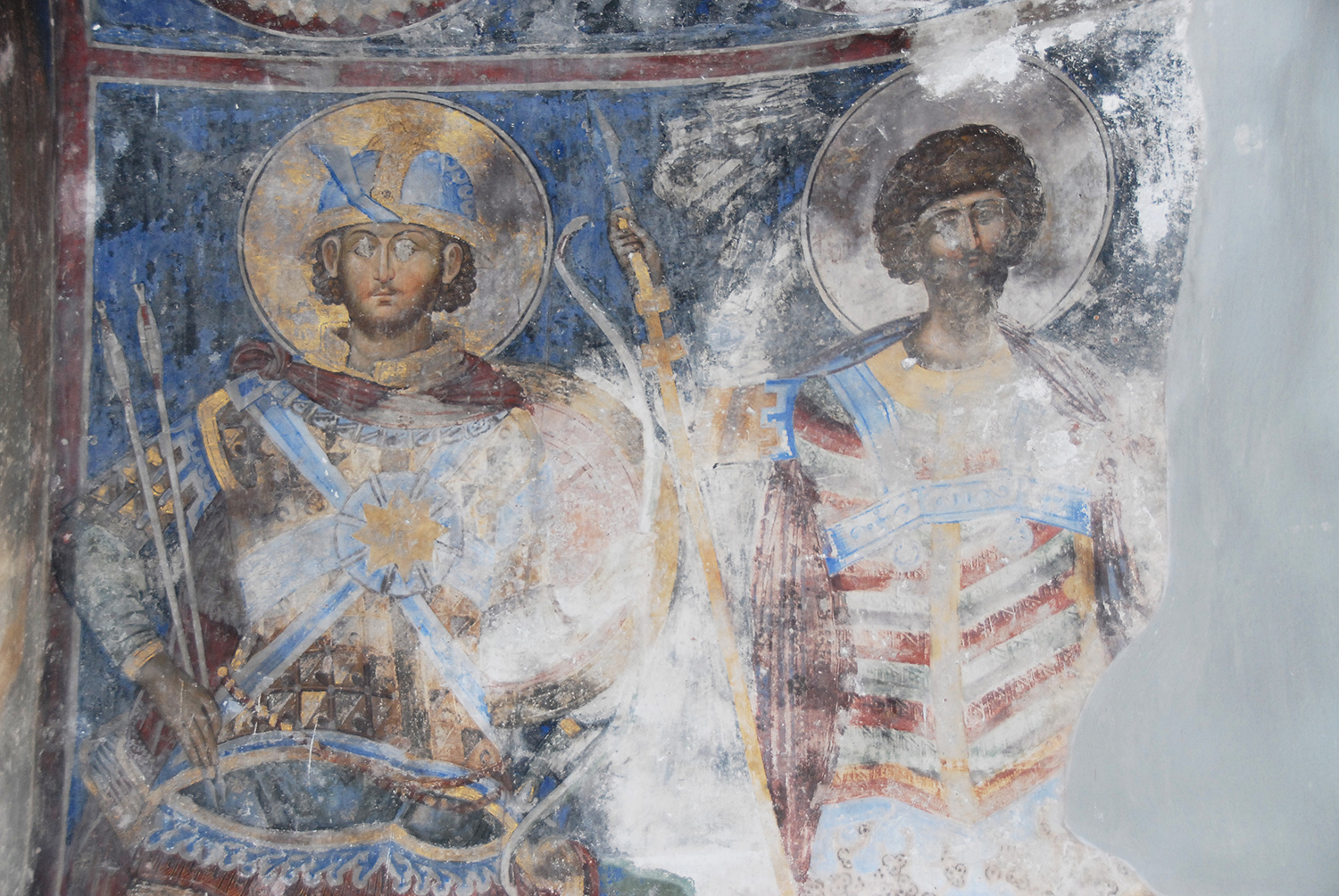
The first zone of the painted decoration in the churches of the Christian orthodox world is designated to the paintings of the standing figures of the elected saints. In the choirs of Resava are represented the Saint warriors: Saint George, Saint Dimitri, Saint Prokopos, Saint Artemije, Saint Jacob The Persian and Saint Evstatios in the south choir, and in the north choir:
-
Saint Theodor Tyron (?), Saint Theodor Stratilat, Saint Merkurije, Saint Nikita, Saint Nestor and Saint Areta. The Saint-Warriors belongs to the best preserved figures on the paintings of Resava and their beauty reach the artistic climax of the Byzantine and Serbian monumental ornamentation as a whole. In the Serbia of the Despot Stefan, at the times of the Turkish invasion, the elected warriors and the reliable defenders of the faith in the Christ, mentioned in the prayers of the faithful and the founders, gave hope and confidence. Some of them are represented in war state poses and others in parade costumes in an elite review. They are painted with their full military equipment, with figures of classical proportions, firm bodies and accentuated volume. The materialisation of the clothing, the military equipment and the weapons is executed by a cautious painting like shearing goldsmith. The Saint martyrs, equal in rank, are painted in the medallions in the choirs. Only the names of Saint Triphon and Saint Ouar, in the north choir, can be read. In the lower window of the south choir are represented Saint Pantheleimon with some medical instruments and an unknown martyr; in the opposite window, in the north choir, are Saint Jovan and another martyr, whereas the paintings of the Stolpnik Saints were represented on the sides of the inferior window of the west bay of the south wall.
The West Wall of the Naos
-
The west part of the naos around the composition of the founder, the Despot Stefan Lazarević is consecrated to the Saint Martyrs who are in the conscious of the monks, eremites, and the skhimniks, which has been repeated in the medallions above them with the busts of the Saint Monks. On the south of the main entrance of the naos are four monumental paintings of Saint Monks, frontally represented and very deteriorated. Above the north entrance, on the west wall, next to the composition of the founder, is frontally painted the bust of Saint Petar Atonski holding a high cross in front of his right shoulder and with his left hand, is showing the second Saint Patron, Saint Onufruja, represented at the very beginning of the north wall. Those two Saints “who live in the desert” are eremites with long beards, long hair, naked and exhausted bodies, with a simple cloth around the hips, spend several decades of seclusion and silent praying on the Mount Aton and in the Egyptian desert, in a deep spiritual ascetical challenge. They’re celebrated on the same day of the Christian calendar. On the lateral walls of the north entrance from the narthex are painted the busts of Saint Chariton the Confessor and an unknown Saint Monk. The inscriptions next to the three busts of the Saint Monks, painted as icons below the windows on the north wall of the west bay of the naos, have not been preserved.
-
On the west side of this window, are frontally represented the standing figures of Saint Varlaam and of Saint Joasaf, whereas above them are the busts of two Saint monks with erased inscriptions. In the serial of the Saint Monks, a place has been designated for the representation of four Saints Doctors, martyrs. On the east side of the window, opposite of Varlaam and Joasaf, are recognised by iconographical details Saint Come and Saint Damian, who are frontally standing, with the medical instruments in their hands, whereas the two paled paintings of the busts of the Saint Doctors above them can’t be identified.
On the east of the inferior northwest window are frontally laid three monumental figures of the Skhimnik Saints. Saint Jefrem Sirin in the middle is holding in his left hand a roll with an unreadable text, whereas his left hand is opened to the spectator. On the deteriorated representations, on the left and the right of Sirin, are recognised Saint Antonije The Great and Saint Arsenije The Great, who are holding in their hands, developed rolls with unreadable and paled texts.
The Ktetor Scene
-
A special place in the whole painted ensemble and complex themes of the paintings of Resava is given to the unique painting, in various aspects of the founder, represented on the west wall of the naos, of the north side of the main entrance. “The Despot Stefan the master of all Serbian lands and the founder of this (Saint) place. The founder of the monastic complex of Manasija, the Despot Stefan Lazarević is represented on a distinguished painting at a mature age with a short beard and short hair, with an stretched and round face, modelled with reddish tunes, with a thin nose and thin eyebrows in the shape of an arc. Dressed in a sumptuous royal dark red chasuble, ornamented with a two-headed golden circular eagles with a golden loros rolled on his left arm. A red cape decorated with golden circles with a two-headed eagle with golden armour on the shoulders. In a solemn and frontal position, he is holding in his right arm the sceptre and with his left hand, he is carrying to the Holy Trinity/ represented in the form of three angels the model of his foundation in Resava and a written prayer on the roll.
-
At the same time, with the act of divine investiture, the Christ makes descending, from a segment of the sky, the crown on the head of the Despot, and the flying angels are bringing him the sword and a lance. On this exceptional picture, plenty of symbols, the Despot Stefan clearly exposed not only his political and state ideas and also the ideas of a man who’s thinking about the Last Judgement and about salvation. In the concept of a royal triumph-act of divine investiture, the Despot is elevated to the order of the Lords who are the representatives of God and the executives of the power according to the will of God. In the same time, he’s addressing poetically by a long prayer written on the developed roll below the model of the church, to God, to the Holy Trinity to receive the temple, his “small offertory” because “ thou art powerful and thou canst bring to salvation those who sinned from whom I’m first appeased”, which three angels with the sceptres- the Holy Trinity, in the west of the painting, receive, blessing the founder.
-
Just next to the portrait of the founder, in the main entry to the naos, are painted the scenes with a clear symbolic eschatological. In the lunette of the main entrance, is represented the scene “The non sleeping-eye”- Christ Emmanuel is lying on the mattress of the bed, and two angels bring him from the sides the sponge, the lance and the cross/ instruments of the future martyr/, which the Holy Virgin is looking at cautiously, stretching the arms as a prayer to the Christ. Above the scene “The non-sleeping eye” in the vault of the entrance, is painted “The Hand of God with the souls of the Just”, in a triple lightened mandorla.
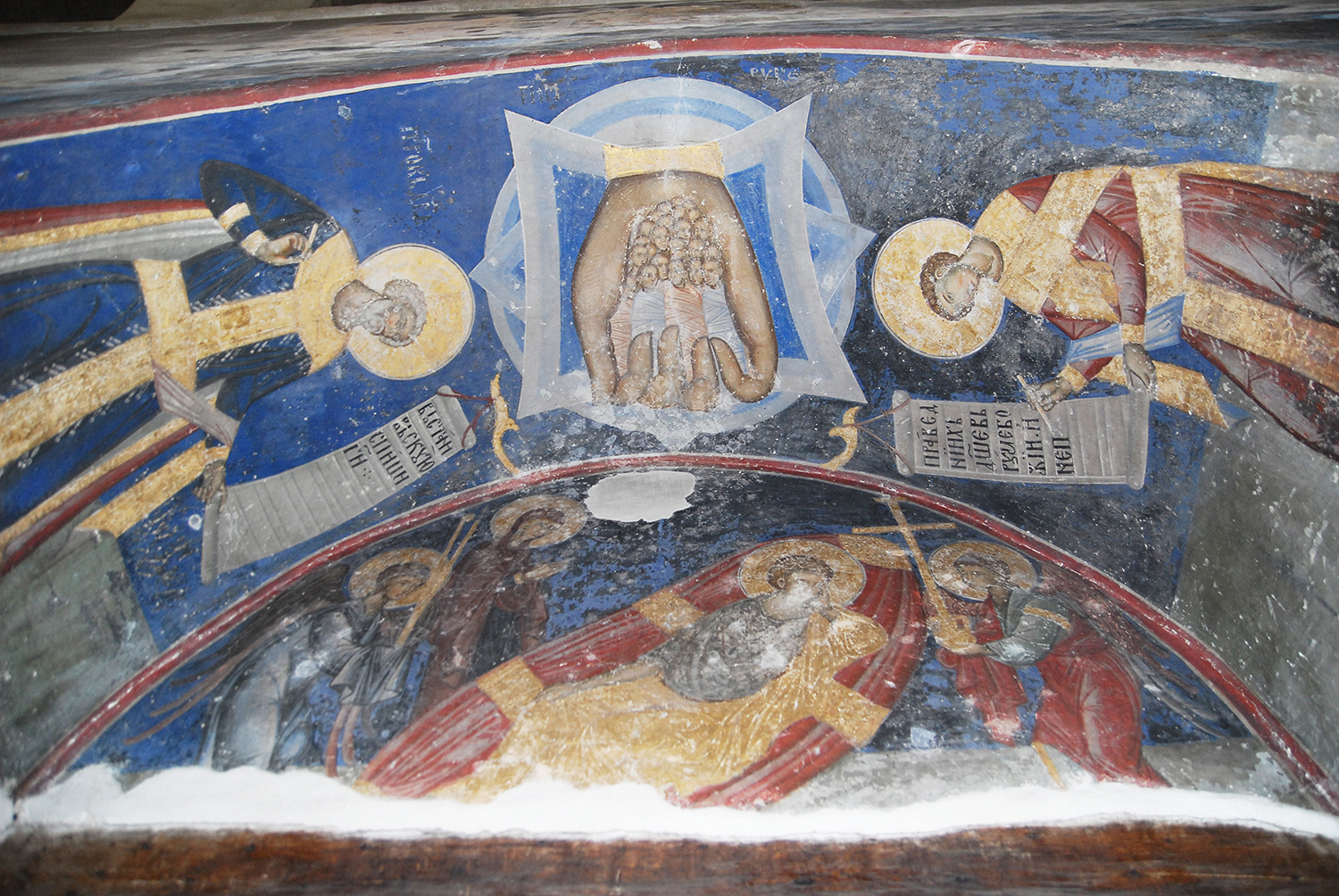
-
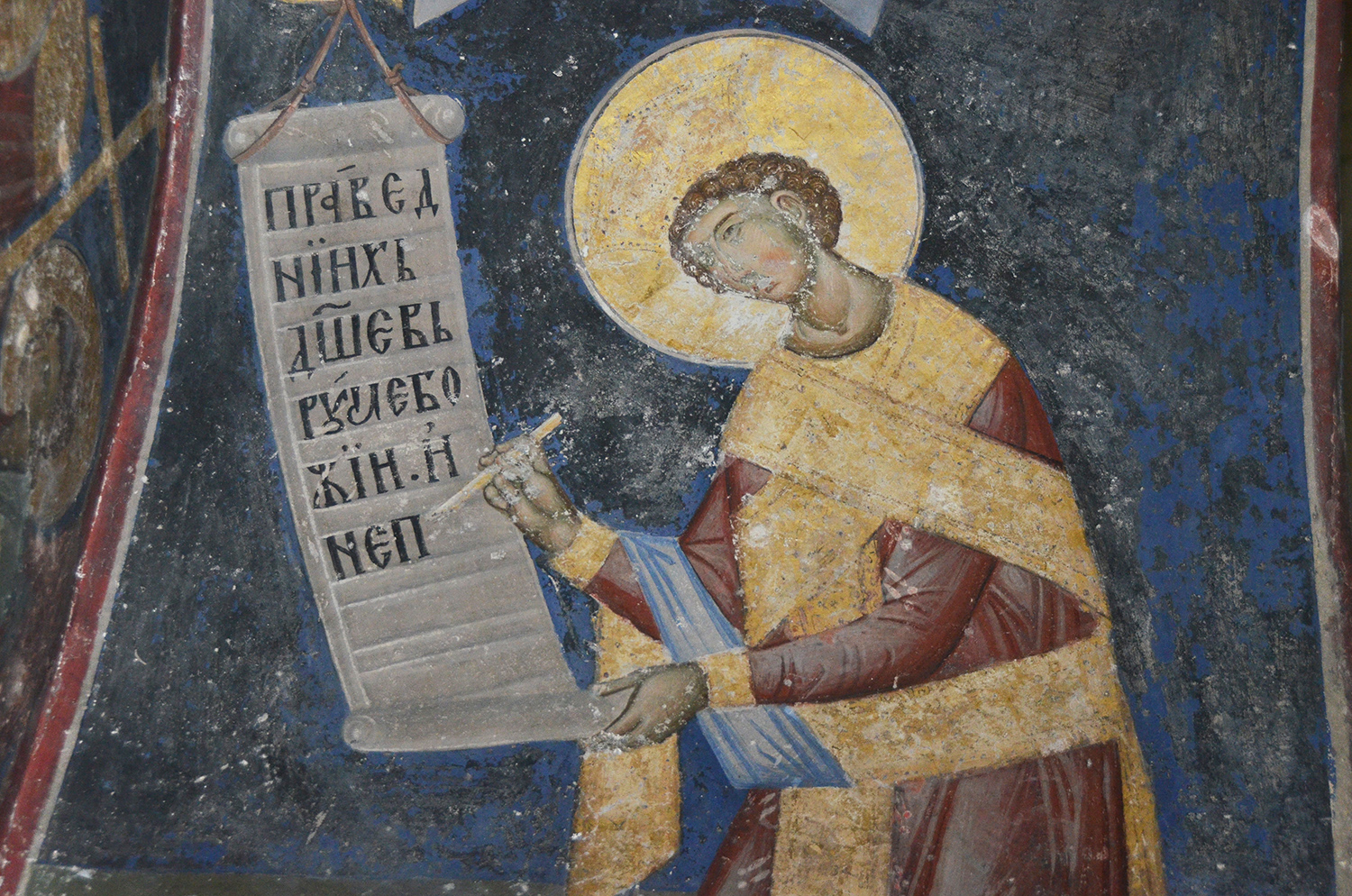
Below of the Hand of God, two kings from the Old Testament, Solomon and David are writing of the rolls the texts of their prophecies, which reveal and confirm the meaning of the painted representations. The prophet David is writing the words from the psalm: “Rise, why are you sleeping my Lord” (psalm 44:23), addressed to the non sleeping-eye, as an allusion the resurrection of the Christ and the prophet Solomon is writing “The soul of the Just in the divine hand” which is an allusion to the “Right Wrist of God” in which the Just will find the salvation at the Last Judgement. Placed above the entrance in the naos, the “Right Wrist of God” shows the hope of salvation to all those who are coming into the foundation of the Despot, so as the temple and the pledge for the salvation of the Despot Stefan thanks to the contribution of the founder.
The Narthex
-
The painting of the narthex has been continued just after the end of the painting of the naos and ended until the consecration of the temple in 1418. Unfortunately, the whole painted decoration of the narthex has been completely destroyed in the explosion of the gunpowder. What remains from the pale fragments of the paintings surely enables to list some the cycles of the early painting program. Above the lunette, above the main entrance, in the naos are found the traces of the original decoration- the sumptuously painted archivolts in stucco with a motive of the wine-plant in colours and with golden leaves so as in the naos, decorated with cornices on the walls and the colonettes next to the pillars. Above the archivolt, on a paled fresco-layer are recognised the fragments of the scenes of the painted cycle of the menologue, whereas on the south wall of the narthex, west from the south doors is only left a part of the representation of the ecumenical Council. To the painting of the artist painters of the Despot Stefan also belong the representation of the bust of the Holy Virgin with the Christ and two angels, painted in the lunette above the north entrance of the narthex, on which, in spite of the important damage, is recognised on daylight an elegant line of refined proportions, an azure-gold palette of the painter of the naos.
The reconstruction of the narthex due to the explosion of the gunpowder has been finished in 1735 when the painters coming from the master’s workshops of Bitola decorated both entrances of the narthex in the naos. In the lunette above the main entrance, was painted the composition “Descending of the Holy Spirit to the apostles” is in the lunette above the north entrance “ The Holy Virgin with risen hands with Christ before her breasts, which is blessing with both stretched hands. Around the lunette and on the doorposts is developed a luxurious floral decoration.
-
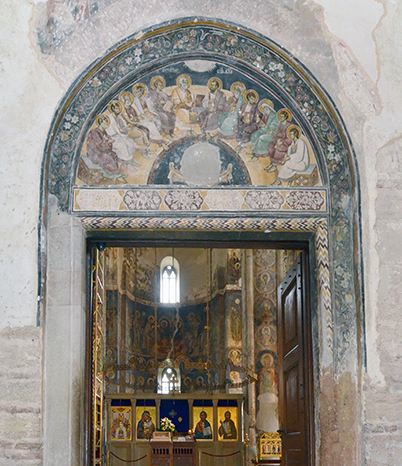
Medallions and Ornaments
-
 The decorative system of the Manasija paintings was realised in exceptional harmony with the architecture. The edifices in Serbia erected by the masters from the coast, owing to their simple and realistic space, determine a more logical layout of the frescoes. Finely treated and secure stone walls make an exceptional foundation for the harmony of architecture and painting.
The decorative system of the Manasija paintings was realised in exceptional harmony with the architecture. The edifices in Serbia erected by the masters from the coast, owing to their simple and realistic space, determine a more logical layout of the frescoes. Finely treated and secure stone walls make an exceptional foundation for the harmony of architecture and painting.A typical characteristic of the Resava polychrome decorations is reflected in the manner of representation of medallions with the busts of saints – martyrs. In the old Serbian art, they can be found only in Ravanica, Kalenić, Manasija, and Sisojevac. Other Morava School monuments, whose paintings are preserved, do not have this type of medallions. That is why the painting of the above monasteries should be viewed as a separate group of this School. Ravanica and Sisojevac have no vine ornaments with tiny saint busts, characteristic of Kalenic and Manasija.
Below the cycle of paintings are represented the busts of the saints in medallions, framed by decorative ribbons with zigzag ranks of rhombus, in the spectre of the colours of the rainbow. A vertical floral wine-plant is represented on the narrow surfaces of the wall, along the lateral choirs, with small cups containing the painted busts of the saint martyrs.
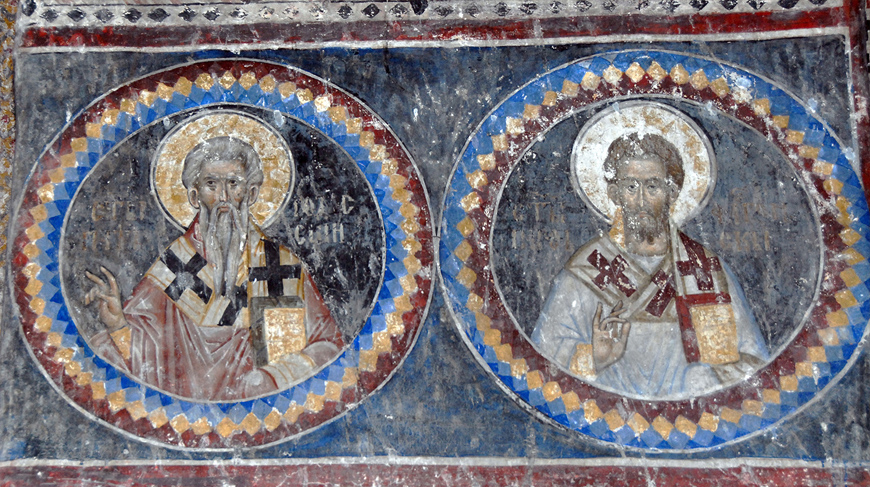
-
The only ornament as a bas-relief in stucco with a richly coloured floral ornament with an important range of colours from the light spectre, and with the thick layers of golden leaves, he’s installed in the cornice along ever wall of the naos, above the pillars, on the dome below the tambour and vertically, on small columns leaned on columns below the dome. On the sides of the pillars are disposed the busts of the saints martyrs one above the other, framed in ribbons in the spectre of the rainbow interlaced in the shape of an 8. Only in the first zone of pillars are represented the standing figures of the saints.
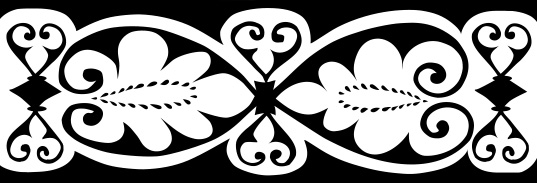
On the inner sides of the west pair of pillars are disposed face to face the leaders of the celestial army of the Christ, the Archangels Michael and Gabriel, whereas on the west side of the same pillars are represented Saint Andrios Stratilatos and Saint Sava Stratilatos. The only scene is the “Vision of Saint Peter of Alexandria”, represented on the south side of the northeast pillar. In the vertical composition on the honour table is represented the Christ as a naked child, enveloped by a narrow and white fabric, and is blessing Saint Peter of Alexandria. This famous defender of the genuine faith at the first ecumenical synod is standing and raising his hands towards the Christ, praying. The heretic Arije, whose teaching has been condemned during the council, is represented shrivelled below the honour table.
